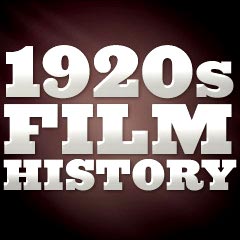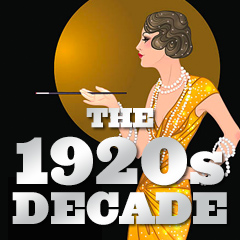 |
The 1920s The Pre-Talkies and the Silent Era Part 1 Film History of the 1920s Part 1, Part 2, Part 3, Part 4 Film History by Decade Index | Pre-1920s | 1920s | 1930s | 1940s | 1950s | 1960s 1970s | 1980s | 1990s | 2000s | 2010s |

|
|
Foundations of the Prolific Film Industry: Films really blossomed in the 1920s, expanding upon the foundations of film from earlier years. Most US film production at the start of the decade occurred in or near Hollywood on the West Coast, although some films were still being made in New Jersey and in Astoria on Long Island (Paramount). By the mid-20s, movies were big business (with a capital investment totaling over $2 billion) with some theatres offering double features. By the end of the decade, there were 20 Hollywood studios, and the demand for films was greater than ever. Most people are unaware that the greatest output of feature films in the US occurred in the 1920s and 1930s (averaging about 800 film releases in a year) - nowadays, it is remarkable when production exceeds 500 films in a year.
Even the earliest films were organized into genres or types, with instantly-recognizable storylines, settings, costumes, and characters. The major genre emphasis was on swashbucklers, historical extravaganzas, and melodramas, although all kinds of films were being produced throughout the decade. Films varied from sexy melodramas and biblical epics by Cecil B. DeMille, to westerns (such as Cruze's The Covered Wagon (1923)), horror films, gangster/crime films, war films, the first feature documentary or non-fictional narrative film (Robert Flaherty's Nanook of the North (1922)), romances, mysteries, and comedies (from the silent comic masters Chaplin, Keaton, and Lloyd). The Major Film Studios: The Big Five 1920-1930 was the decade between the end of the Great War and the Depression following the Stock Market Crash. Film theaters and studios were not initially affected in this decade by the Crash in late 1929. The basic patterns and foundations of the film industry (and its economic organization) were established in the 1920s. The studio system was essentially born with long-term contracts for stars, lavish production values, and increasingly rigid control of directors and stars by the studio's production chief and in-house publicity departments. After World War I and into the early 1920s, America was the leading producer of films in the world - using Thomas Ince's "factory system" of production, although the system did limit the creativity of many directors. Production was in the hands of the major studios (that really flourished after 1927 for almost 20 years), and the star system was burgeoning. Originally, in the earliest years of the motion picture industry, production, distribution, and exhibition were separately controlled. When the industry rapidly grew, these functions became integrated under one directorship to maximize profits, something called vertical integration. There were eight major (and minor) studios (see below) that dominated the industry. They were the ones that had most successfully consolidated and integrated all aspects of a film's development. By 1929, the film-making firms that were to rule and monopolize Hollywood for the next half-century were the giants or the majors, sometimes dubbed The Big Five. They produced more than 90 percent of the fiction films in America and distributed their films both nationally and internationally. Each studio somewhat differentiated its products from other studios. See History of Film Studio Logos.
The Big-Five studios had vast studios with elaborate sets for film production. They owned their own film-exhibiting theatres (about 50% of the seating capacity in the US in mostly first-run houses in major cities), as well as production and distribution facilities. They distributed their films to this network of studio-owned, first-run theaters (or movie palaces), mostly in urban areas, which charged high ticket prices and drew huge audiences. They required blind or block bookings of films, whereby theatre owners were required to rent a block of films (often cheaply-made, less-desirable B-pictures) in order for the studio to agree to distribute the one prestige A-level picture that the theatre owner wanted to exhibit. This technique set the terms for a film's release and patterns of exhibition and guaranteed success for the studio's productions. [Monopolistic studio control lasted twenty years until the late 1940s, when a federal decree (in U.S. vs. Paramount) ordered the studios to divest their theatres, similar to the rulings against the MPPC - the Edison Trust.] The Minor Film Studios: The Little Three Three smaller, minor studios were dubbed The Little Three, because each of them lacked one of the three elements required in vertical integration - owning their own theaters:
"Poverty Row" Studios and Other Independents: Other studios or independents also existed in a shabby area in Hollywood dubbed "Poverty Row" (Sunset Blvd. and Gower Street) where cheap, independent pictures were made with low budgets, stock footage, and second-tier actors. It was the site of Harry and Jack Cohn's new business, the C.B.C. Film Sales Company (later becoming Columbia Pictures). Many of the films of the independents were either horror films, westerns, science-fiction, or thrillers:
Extravagant Movie Palaces: Grauman's Theatres:
Star Imprints at Grauman's: Grauman, dubbed as "Hollywood's Master Showman," established the tradition of having Hollywood stars place their prints in cement in front of the theater to create an instant tourist attraction ever since. (Legend has it that during the theatre's construction, silent screen actress Norma Talmadge accidentally stepped into wet cement and inspired the tradition. Grauman immortalized his own footprints, and invited Mary Pickford and Douglas Fairbanks to do the same.) Listed below are the first 10 stars, beginning in the spring of 1927, to imprint themselves (with handprints, footprints, or signatures) in the concrete of the Chinese Theatre's forecourt:
Pickford and Fairbanks: She was married to another great star, Douglas Fairbanks, Sr. Their wedding in late March, 1920 was a major cultural event, although it was highly controversial since both of them had to divorce their spouses so they could marry each other. She was presented with a wedding gift - "Pickfair" [the first syllables of their last names], a twenty-two room palatial mansion (former hunting lodge) in the agricultural area of Beverly Hills - marking the start of the movement of stars to lavish homes in the suburbs of W. Hollywood and the making of Hollywood royalty. [The couple remained married from 1920-1935.] Strangely, Mary Pickford's downfall began after she bobbed her long curly hair, one of moviedom's first fashion trends, in 1928.
Another first occurred in 1926 - a Hollywood film premiere double-featured two films together: Fairbanks' The Black Pirate (1926) with early two-color Technicolor (and the superstar's most famous stunt of riding down a ship's sail on the point of a knife) and Mary Pickford's melodramatic film Sparrows (1926). Fairbanks scored again at the close of the decade with The Iron Mask (1929). The first and only film that co-featured both stars was a talkie version of The Taming of the Shrew (1929). Pickford's Coquette (1929), her first all-talking film, won her an Academy Award, but she retired prematurely four years later. Other 1920s Box-Office Stars: The top box-office stars in the 1920s included Harold Lloyd, Gloria Swanson, Tom Mix, Norma Talmadge, Rudolph Valentino, Douglas Fairbanks Sr., Colleen Moore, Norma Shearer, John Barrymore, Greta Garbo, Lon Chaney, Sr., Clara Bow, and "Little Mary" Pickford.
Young screen actress, platinum blonde starlet Jean Harlow was also 'discovered' and soon contracted with aviation millionaire/movie mogul Howard Hughes to replace the female lead in his soon-to-be-released, re-made sound version of Hell's Angels (1930), another exciting WWI film about British flying aces. Janet Gaynor: Janet Gaynor was also honored in the same year with an Academy Award for her exquisite acting in German director F. W. Murnau's first American film - the beautiful Fox-produced Sunrise: A Song of Two Humans (1927), often considered the finest silent film ever made by a Hollywood studio. Murnau's succeeding films were The Four Devils (1928) and Our Daily Bread (1930), with his last film the sensual semi-travelogue documentary Tabu: A Story of the South Seas (1931) shot with documentarist Robert Flaherty. (A week before Tabu's premiere in early March 1931, Murnau died in a car accident.)
Part 1, Part 2, Part 3, Part 4 | ||||||||||||||||||||||||||||||||||||||||||||||||||||